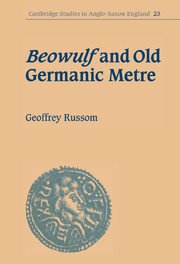Book contents
- Frontmatter
- Contents
- Preface
- List of abbreviation
- 1 Introduction
- 2 The foot
- 3 The verse
- 4 Light feet and extrametrical words
- 5 Metrical archaisms
- 6 Alliteration
- 7 Metrical subordination within the foot
- 8 Resolution
- 9 Word order and stress within the clause
- 10 Old Saxon alliterative verse
- 11 Hildebrandslied
- 12 Conclusions
- Appendix: Rule summary
- Bibliography
- Index
- Verses specially discussed
10 - Old Saxon alliterative verse
Published online by Cambridge University Press: 02 November 2009
- Frontmatter
- Contents
- Preface
- List of abbreviation
- 1 Introduction
- 2 The foot
- 3 The verse
- 4 Light feet and extrametrical words
- 5 Metrical archaisms
- 6 Alliteration
- 7 Metrical subordination within the foot
- 8 Resolution
- 9 Word order and stress within the clause
- 10 Old Saxon alliterative verse
- 11 Hildebrandslied
- 12 Conclusions
- Appendix: Rule summary
- Bibliography
- Index
- Verses specially discussed
Summary
Anyone accustomed to the metrical norms of Beowulf or Prymsqviða will be struck by the high frequency of unstressed words in the Heliand, which narrates the life of Jesus in alliterative metre. Sievers observes that liberal employment of extrametrical syllables in this Old Saxon work can make assignment of verses to metrical types quite difficult. The Heliand is problematic in other respects as well. Its many exotic biblical names, for example, have uncertain metrical values. In ch. 6 above, we used frequencies of optional alliteration to determine the metrical prominence of subordinate S and s positions. Frequencies for the Heliand are unfortunately not comparable, since the author tends to avoid the traditional heroic diction, with its stock of alliterating phrases. Old English evidence suggests that rejection of warlike epithets in favour of New Testament values made it significantly more difficult to supply a second alliterating syllable for the a-verse.
Despite its problematic character, the Heliand provides valuable data for comparative study. Old Saxon alliterative frequencies may be skewed, but we can often determine the relative prominence of a metrical position by attending to the placement of resolvable sequences. Some Old Saxon verses may have uncertain scansions, but no special problems arise in twoword verses, which express their underlying patterns directly, providing crucial cases for all applicable rules. As we shall see, some rather complex verses also have unambiguous word-foot scansions; and verses with no determinate scansion prove surprisingly useful for some purposes.
- Type
- Chapter
- Information
- Beowulf and Old Germanic Metre , pp. 136 - 170Publisher: Cambridge University PressPrint publication year: 1998

